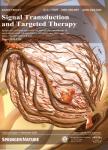Predictive biomarkers of response and survival following immunotherapy with a PD-L1 inhibitor benmelstobart(TQB2450)and antiangiogenic therapy with a VEGFR inhibitor anlotinib for pretreated advanced triple negative breast cancer
作者机构:National Cancer Center/National Clinical Research Center for Cancer/Cancer HospitalChinese Academy of Medical Sciences and Peking Union Medical CollegeBeijing 100021China Liaoning Cancer Hospital&InstituteShenyangLiaoning 110042China Hunan Cancer HospitalChangshaHunan 410013China Geneplus-ShenzhenShenzhen 518118China
出 版 物:《Signal Transduction and Targeted Therapy》 (信号转导与靶向治疗(英文))
年 卷 期:2023年第8卷第12期
页 面:5944-5953页
核心收录:
学科分类:1002[医学-临床医学] 100214[医学-肿瘤学] 10[医学]
基 金:supported by CAMS Innovation Fund for Medical Sciences(CIFMS,2022-I2M-2-002) CAMS Innovation Fund for Medical Sciences(CIFMS,2021-I2M-1-014) Beijing Hope Run Special Fund of Cancer Foundation of China(LC2022A18) CHIA TAI TIANQING PHARMACEUTICAL GROUP
摘 要:In our phase Ib trial(*** Identifier:NCT03855358),benmelstobart(TQB2450),a novel humanized IgG1 antibody against PD-L1,plus antiangiogenic multikinase inhibitor,anlotinib,demonstrated promising antitumor activities in pretreated triple negative breast cancer(TNBC)*** conducted explorative analyses of genomic biomarkers to explore the associations with treatment response and survival *** next generation sequencing(NGS)was undertaken toward circulating tumor DNA(ctDNA)collected from peripheral blood samples prior to the start of treatment and after disease progression.A total of 31 patients received targeted NGS and functional driver mutations in 29 patients were *** most frequent mutations were TP53(72%),MLL3(28%),and PIK3CA(17%).At a blood-based tumor mutational burden(bTMB)cutoff of 6.7 mutations per megabase,patients with low bTMB showed better response to anlotinib plus TQB2450(50%vs.7%,P=0.015)and gained greater PFS benefits(7.3 vs.4.1 months,P=0.012)than those with high *** a maximum somatic allele frequency(MSAF)cutoff of 10%,a low MSAF indicated a better objective response(43%vs.20%)as well as a significantly longer median PFS(7.9 vs.2.7 months,P0.001).Patients with both low MSAF and low bTMB showed a notably better objective response to anlotinib plus TQB2450(70%vs.11%,P0.001)and a significantly longer median PFS(11.0 vs.2.9 months,P0.001)than patients with other *** findings support future studes and validation of MSAF and the combined bTMB-MSAF classification as predictive biomarkers of immune checkpoint inhibitor-based regimens in advanced TNBC patients.



